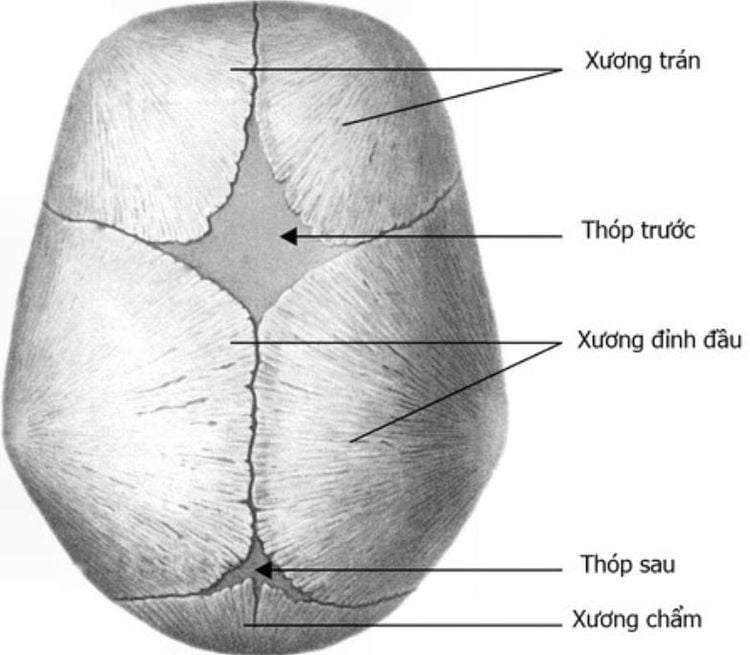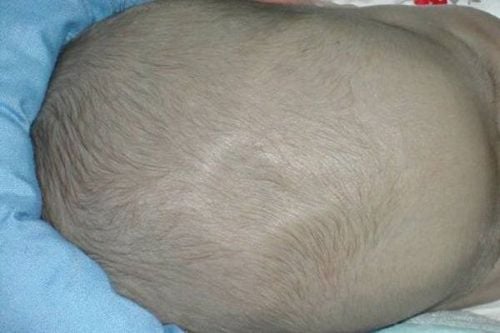This is an automatically translated article.
The article was professionally consulted by resident Doctor Duong Van Sy - Department of Pediatrics - Neonatology - Vinmec Hai Phong International General Hospital. Doctor has 09 years of experience in the field of Pediatrics.For the most part, the indentation of the fontanelle in newborns or its undulations and then return to its original state is considered normal. This is caused by blood flow through this area. However, a concave fontanelle in a child can also warn of some dangerous symptoms in the baby such as lack of water, malnutrition,...
1. fontanelle in babies
In babies, 2 soft spots on the head are called fontanels. Fonts can often vary slightly in size. The posterior fontanelle is usually about 0.6cm smaller and has a triangular shape. The anterior fontanel is larger, measuring about 2.5cm, located at the top of the head and is diamond or kite-shaped. If the fontanelle size is small or larger than the average size, the baby needs to be examined and checked immediately.The fontanel plays a role in making it easier for the baby to be born. Specifically, at birth, the baby's head bones are soft and connected by tissues. When the baby comes out from the mother's vagina, the fontanelle allows the baby's skull to be flexible, pressing together to make it easier for the baby to come out. In addition, the fontanelle also plays a role in creating space for the baby's brain to develop like an adult.
The fontanelle is a soft spot but is protected by a very thick membrane until the bones fuse together. Therefore, light collisions such as wearing a hat, washing hair... will not affect the fontanelle.
The fontanel will be stretched for the first 2-3 months and then the fontanel will start to heal. Because the posterior fontanelle is small, it will be immediately in front of the anterior fontanel, immediately after the baby is 2-4 months old; Anterior fontanelle will heal when the baby is about 18-24 months old, but there are also cases that heal earlier, about 9-12 months old. Until it heals, the fontanelle of the baby is always flat, not concave, not bulging.

2. What is the cause of the indented fontanelle in an infant?
For the most part, the fontanelle in newborns either rises and falls like a wave and then returns to its usual state that is considered normal. This is caused by blood flow through this area. However, indented fontanelles in children can also warn of a few symptoms in children that parents should pay attention to, because indented fontanels can be a sign of:Baby lack of water: This is the main cause of fontanelles. in infants. The lack of water in the body makes the child not have enough fluid to maintain normal activities. This is a dangerous situation, so parents need to pay attention to recognize the signs to take the baby to a medical facility promptly, to prevent dangerous complications from occurring. Malnutrition : Malnutrition can cause symptoms of recessed fontanelle in children. This symptom is often accompanied by signs of dehydration and makes the fontanelle in children more dangerous. Malnourished infants often have other accompanying signs such as underweight, dry hair that falls out easily, fatigue, lethargy, and poor skin elasticity. Acute Toxic Colitis: In rare cases, acute toxic colitis causes the fontanelle to sink in. This is a rare but life-threatening condition. Kwashiorkor: This is known as multi-nutrient deficiency syndrome in young children, caused by a lack of protein in the baby. With treatment, children with this syndrome also cannot achieve full development. However, treatment too late can lead to permanent physical and mental disabilities. Or untreated illness can lead to coma, shock, or even death. Diabetes insipidus: Diabetes insipidus is not a form of diabetes but a rare condition that occurs when a child's kidneys are unable to retain water, creating a fontanelle in infants. Depending on the severity, the doctor will offer different treatment options.
3. Diagnosis and treatment of indented fontanelles in infants?
Usually, the doctor will use the following methods to diagnose a recessed fontanelle in a child:First, physical examination of the baby: The physical examination of the baby includes looking at and touching the area of the fontanelle. . Assess the baby's skin elasticity, because if the elasticity is poor, it may be due to a lack of water. Ask about your baby's symptoms: The doctor will probably ask when your baby's fontanel appears to be in order to assess the extent of your baby's condition. Tests: Tests that involve taking a blood or urine sample are often ordered when a child has signs of a fontanelle. Tests include a complete blood count, which measures the number of white blood cells and red blood cells and their components to detect infections and anemia caused by dehydration. Besides, urine test aims to check for abnormal conditions that the baby may have. Another test that your doctor may order in case of a fontanelle in your baby is a comprehensive metabolic test, which measures how well chemicals in the body are broken down and how the baby's body uses food. How is the product different?

Enhance fluid absorption: This is a treatment for indented fontanelles when the baby is dehydrated. You can do this by feeding your baby more often and more often. Supplementation with electrolytes: The doctor will prescribe the use of electrolytes formulated specifically for infants in the treatment of concave fontanelles in children to improve malnutrition. However, if your baby is dehydrated due to the sugar and salt content in the electrolyte mix, this method should not be used as it will cause further dehydration for the baby. Indented fontanelles in infants are a dangerous warning condition, so when noticing the phenomenon of fontanelles in children, parents should take the child to the doctor as soon as possible, do not arbitrarily treat the baby at home. The pediatric department at Vinmec International General Hospital is the address for receiving and examining diseases that infants and young children are susceptible to. With a system of facilities, modern medical equipment, sterile space, minimizing the impact as well as the risk of disease spread, Vinmec will bring satisfaction to customers and receive expert advice from experts. Highly appreciated by experts in the industry with:
Gathering a team of leading pediatricians: including leading experts with high professional qualifications (professor, associate professor, doctorate, master), experienced, worked at big hospitals like Bach Mai, 108.. The doctors are all well-trained, professional, have a heart - reach, understand young psychology. In addition to domestic pediatric specialists, the Department of Pediatrics also has the participation of foreign experts (Japan, Singapore, Australia, USA) who are always pioneers in applying the latest and most effective treatment regimens. . Comprehensive services: In the field of Pediatrics, Vinmec provides a series of continuous medical examination and treatment services from Newborn to Pediatric and Vaccine,... according to international standards to help parents take care of their baby's health from birth to childhood. Advanced techniques: Vinmec has successfully deployed many specialized techniques to make the treatment of difficult diseases in pediatrics more effective: neurosurgery - skull, stem cell transplant blood in cancer treatment. Professional care: In addition to understanding children's psychology, Vinmec also pays special attention to the children's play space, helping them to play comfortably and get used to the hospital's environment, cooperate in treatment, improve the efficiency of medical treatment.
Please dial HOTLINE for more information or register for an appointment HERE. Download MyVinmec app to make appointments faster and to manage your bookings easily.
| Đăng ký tư vấn dinh dưỡng cho bé tại: https://i.vinmec.com/dangkytuvandinhduong |
|---|














